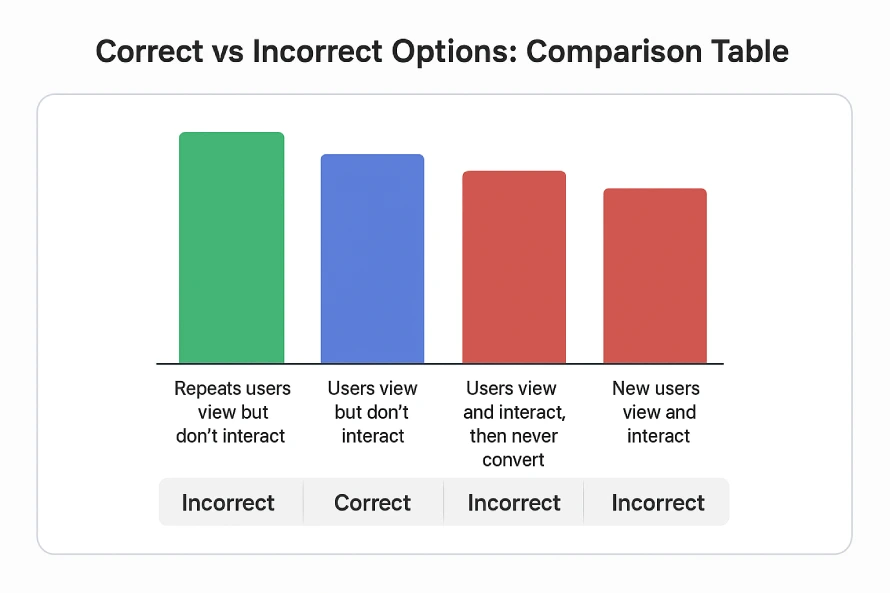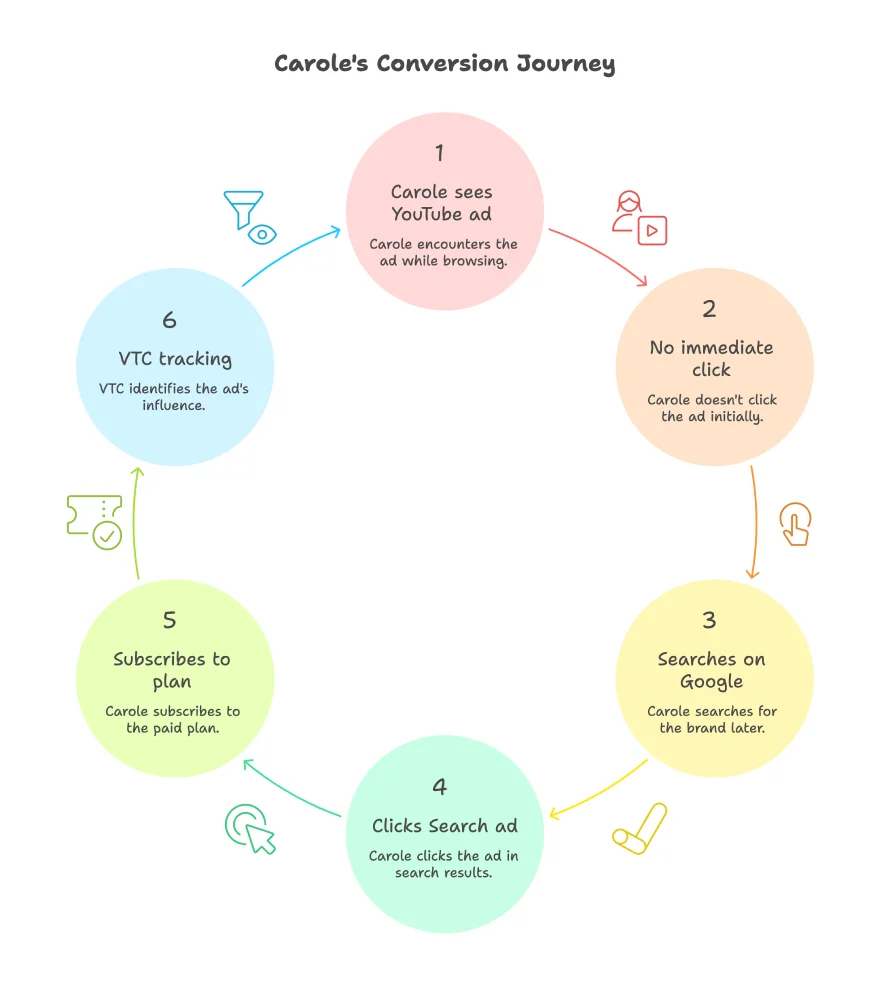Not every customer clicks an ad before buying. Sometimes just seeing an ad influences a later decision. Google Ads measures this indirect effect with view-through conversions (VTCs). Knowing how VTCs are counted helps advertisers see the real value of display and video campaigns.
In this article from Miteart, I’ll break down how view-through conversions are counted, why the correct answer matters, and where advertisers often get confused. This is a real Google Ads Measurement Certification question. So, no delay. Let’s get started.
Table of Contents
The Question
How are view-through conversions counted?
- They’re counted as conversions that are recorded when repeat users view but don’t interact with an ad, then later convert.
- They’re counted as conversions that are recorded when users view but don’t interact with an ad, then later convert.
- They’re counted as conversions that are recorded when users view and interact with an ad, then never convert.
- They’re counted as conversions that are recorded when new users view and interact with an ad, then later convert.
The Correct Answer
✅ They’re counted as conversions that are recorded when users view but don’t interact with an ad, then later convert.
Why the Correct Answer Is Right
View-through conversions are specifically designed to capture the value of ad impressions. Here’s how it works:
- A user sees your display ad, YouTube ad, or app campaign ad.
- They do not click or engage with it in that moment.
- Later, within the conversion window (often 30 days, but customizable), the same user completes a conversion action such as purchasing, subscribing, or filling out a form.
The logic is simple: just because a user didn’t click doesn’t mean the ad had no influence. Maybe your ad planted the idea, reminded them of your brand, or built trust. This is especially critical in brand campaigns where visibility matters more than immediate clicks.
Why the Other Options Are Wrong
1. “Repeat users view but don’t interact with an ad, then later convert.”
This is wrong because view-through conversions don’t care if it’s a repeat or new user. They track all users exposed to the ad, regardless of prior visits.
3. “Users view and interact with an ad, then never convert.”
Incorrect. If a user interacts (clicks), that’s a click-based conversion, not view-through. And if they never convert, no conversion is recorded at all.
4. “New users view and interact with an ad, then later convert.”
Wrong because this mixes interaction (which removes it from being a view-through) and limits it to new users. The definition applies to any user who sees but does not interact.
Correct vs Incorrect Options: Comparison Table
| Option | Answer Text | Correct or Incorrect | Why |
|---|---|---|---|
| 1 | They’re counted as conversions that are recorded when repeat users view but don’t interact with an ad, then later convert. | ❌ Incorrect | VTC applies to all users, not just repeat users. |
| 2 | They’re counted as conversions that are recorded when users view but don’t interact with an ad, then later convert. | ✅ Correct | This is the exact definition of view-through conversions. |
| 3 | They’re counted as conversions that are recorded when users view and interact with an ad, then never convert. | ❌ Incorrect | If they interact, that’s a click-based conversion (if completed). No conversion is recorded if they never convert. |
| 4 | They’re counted as conversions that are recorded when new users view and interact with an ad, then later convert. | ❌ Incorrect | Again, interaction = click, not view-through. And VTC applies to all users, not just new ones. |

Real-Life Example
Let’s say Carole is browsing YouTube and sees your ad for a new fitness app. She doesn’t click, just continues watching other videos. Two days later, Carole searches for your brand on Google, clicks your Search ad, and subscribes to your paid plan.

Without view-through conversions, it would look like your YouTube ad did nothing. But thanks to VTC tracking, you can see the ad actually influenced Carole’s decision, even though she didn’t click at first.
Relevant Resource Links to Learn
Here are the best resources to deepen your knowledge:
- Google Ads Help – About View-Through Conversions
- Skillshop – Google Ads Measurement Certification
- Think with Google – The Power of Attribution
- Google Analytics 4 – Conversion Tracking Guide
- Search Engine Journal – View-Through Conversions Explained
Conclusion
View-through conversions occur when someone sees your ad but doesn’t click it, then later completes a conversion. They show that impressions can influence customer behavior even without clicks.
I hope this explanation makes the concept clear and helps you answer correctly in the Google Ads Measurement Certification exam. If you’re ready, you can take the exam on Skillshop today. And stay tuned—more real exam questions and answers are coming, each explained in detail to help you master Google Ads!
FAQs
Do search ads record view-through conversions?
No. VTCs are primarily tied to display, video, and app campaigns, not text-based search ads.
What is the default view-through conversion window?
The default is 30 days, but advertisers can adjust this window based on campaign goals.
Are view-through conversions weighted the same as click conversions?
Not necessarily. Many advertisers assign less value to VTCs because they reflect indirect influence rather than direct engagement.
Do VTCs include cross-device tracking?
Yes. If a user views an ad on one device and later converts on another (logged into Google), it can still count as a view-through conversion.
Can view-through conversions improve bidding strategies?
Yes. Smart Bidding in Google Ads considers VTC data to optimize campaigns, especially for branding and awareness-driven objectives.
